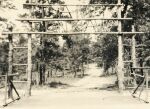 |
Campsites |
 |
Campsites |
| In the early days each
campsite had a covered screened-in eating area with four tables and sixteen
benches and an outside fire place which dishwashing and rinsing were done.
Later, when the camp when to central feeding, the screened in areas became
open shelters.
There were four cold water showers to serve the eight campsites. Each campsite had its own outdoor wash trough for hand washing and brushing of teeth. |
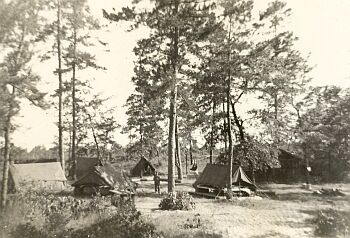 |
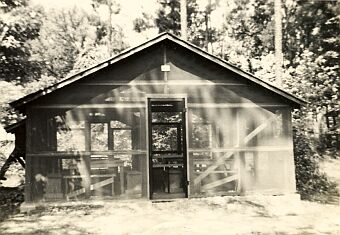
|
Paul Yater said: “There was a central kitchen where cooks prepared meals. Each Troop had two-man carriers and would go to the kitchen and bring back pots and pans of food to be eaten in the campsite’s screened-in dining area that had no floor. There were four tables, each with four benches. The Service Patrol dished out the food for each table, and it was served at the tables family style. Shown in the two photos on the left is the dining area in Campsite 11 taken in 1948.
|
| "After eating, water
was heated on a wood fire, in a rock fireplace, and all pans, pots, plates
and eating utensils were washed and scalded. The pots, pans and water
pitchers were returned to the kitchen for inspection. If not clean,
they were sent back to be re-done. Needless to say, there were times
when dish washing was going on at midnight. But, it was fun.”
1948 Photo on right: John Head, Lon Royce McLaughlin, David Ash, Jo Bob Casey, Bobby Crawford and Robert Cargill, jr. |
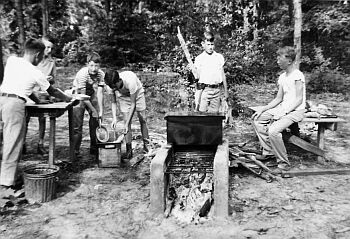 |
 |
Here a patrol is standing
at ease in preparation for camp inspection prior to going to the main lodge
for the flag ceremony on parent's night.
Shown in the photo on the left is Frank Hilton, Patrol Leader, Larry Stewart and Billy Bennett. Their Eagle Patrol won the camp inspection that day in June 1948. |
| Floyd Walton said “I
don’t remember a lot about the first summer camp I went to at Camp Tonkawa,
but I do remember being inducted into the Royal Order of Siam. Nowadays
we have to be so careful not to be accused of hazing or anything like it,
but rest assured the Royal Order of Siam still meets at summer camp in
our troop. I also remember the old swimming hole at Tonkawa.
That had to be the coldest water anywhere in Texas. It is now the
source of Ozarka spring water.”
1948 Photo on right: Sam Handly and Green Chandler |
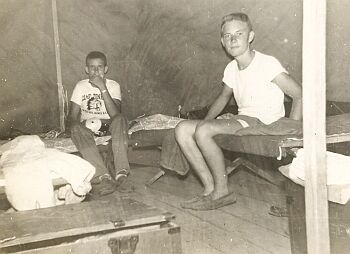 |
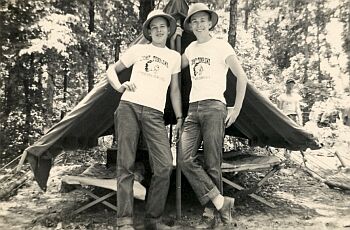 |
Pictured to your left are Frank Linville and Paul Yater, Assistant Scoutmasters of Troop 201 in 1948. Paul Yater is still a member of their Troop Committee and wrote a book on the history of the troop. |
| Frank Hilton said: "R.
W. (Red) Whitworth, our Scoutmaster, would take the boy leaders of the
Troop to Camp Tonkawa the day before summer camp opened so that we could
clean up the latrine, showers, move the tent platforms and set up the tents
in a straight line before everyone came to camp the following day. We would
ride on the back of a ton and a half truck he owned with all the gear piled
on the back with us. We usually rode with our feet dangling off the back
of the truck bed.
1948 Photo on right:
|
 |
 |
"Our favorite stopping
place was in Mt. Enterprise, Texas where we stopped for lunch and played
the pinball machines! The Scoutmaster had trouble getting us to stop playing
the machine long enough to eat and get back into the truck."
On the left and below are photos of campsite 11. Note the tent platforms. When moving the platforms each season we had to watch for copperheads and rattle snakes that made their winter home under the platforms. |
| Frank Hilton said “We went to summer camp each summer and usually stayed in campsite 10 or 11 on the backside of Camp Tonkawa. One year, a group of us with nothing to do decided to dig a hole on the backside of the campsite and cover it with pine branches and pine needles. The idea was to have someone fall into the hole the following week of camp when we were not there. | 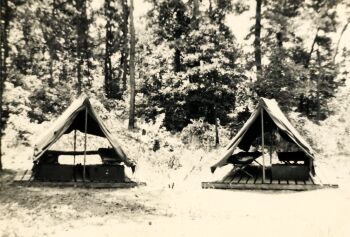 |
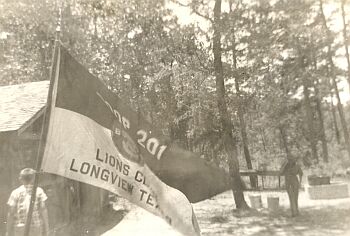 |
We couldn’t wait to get
back to camp the following year to see what had happened! Sure enough,
something had fallen into the hole. We never knew, to the day, whether
or not it was an animal, human, or just rotted away. We were such sweet
innocent kids in those days."
Photo on the left shows the campsite screened in dining area, and in the background, the clean up area. |
|
In the photo on the right is Larry "Buster" Crabb standing in front of the leader's tent with his bugle. It was his job to get the troop awake in the mornings and play taps at night. |
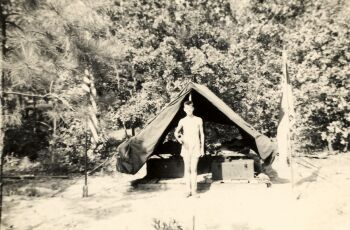 |
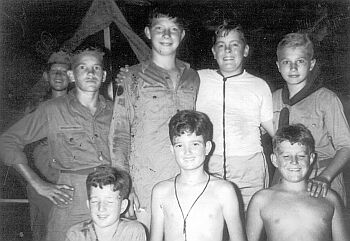 |
On the left is a group of Scouts enjoying the fellowship and came with being together for a week at summer camp. |
| Here is a color photo of one of the campsites. See the empty shelter on the right that used to be a campsite dining hall. | 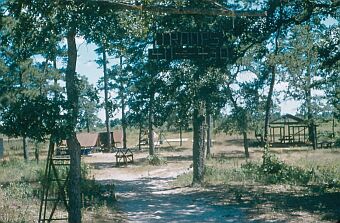 |
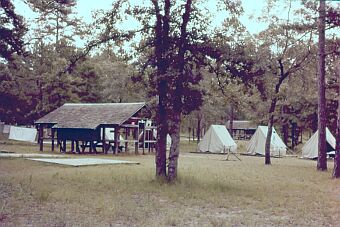 |
Once the feeding of Scouts was moved from the troop campsite to a central dining area, the campsite screened in dining halls were converted to open shelters as shown in the photo to your right. |
| Shown on the right is the entrance to Palestine's Troop 441's campsite. Looks like they had some rain that day. The shelter is behind the tent on your right. | 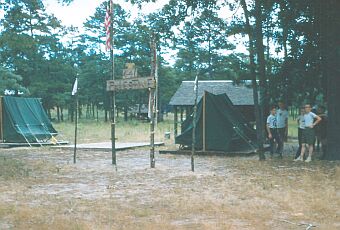 |
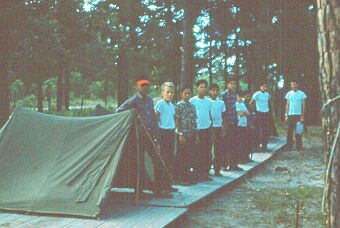 |
We are ready for a week of fun. Not sure everyone will fit in that pup tent. |
| Unloading gear to go to campsite. | 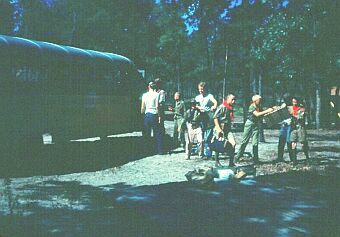 |
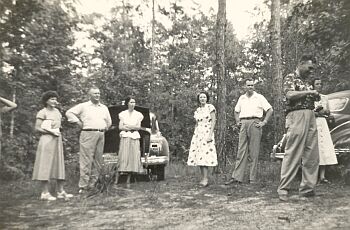 Frank
Hilton remembers that "Thursday nights were Parent's Night at Camp Tonkawa.
We looked forward to not having to eat camp food and always had plenty
of parents show up with sandwiches, fried chicken, and other great food
for supper. It was a feast for us after having been in camp since Sunday." Frank
Hilton remembers that "Thursday nights were Parent's Night at Camp Tonkawa.
We looked forward to not having to eat camp food and always had plenty
of parents show up with sandwiches, fried chicken, and other great food
for supper. It was a feast for us after having been in camp since Sunday."
1948 Photo Left to Right - Mrs. Cunningham, Mr. and Mrs. Randal Price, Mr. and Mrs. J. B. Head, Mr. Cunningham, Mrs. Bob Cargill. "One time, Mr. Harrison, John Harrison’s father, got his car stuck in the sand just outside camp. Several of us volunteered to go out and try to help him get the car out of the sand and into camp. We ended up jacking up the car and putting pine branches under the back wheels in order for him to get enough traction to get out of the sand. Of course, we were in the back pushing with all our might at the time. There was one hill before you got to the gate of camp and during dry weather, with all the traffic on the sandy road, one could get stuck if they did not drive right in the middle of the road. This was the spot he got his car stuck. Being as one was going uphill it was almost impossible to get out of the sand unless one had help."
Information for this page, in part, taken from A History Of Troop 1 (201) 1917 - 2002 by Paul A. Yater, 2002 | Home
| Facilities | Program
| Waterfront | Camp Songs
| Patches | Neckerchiefs
| Maps |
|